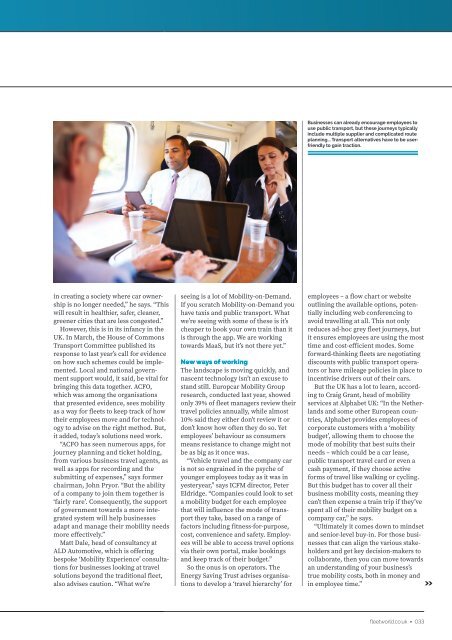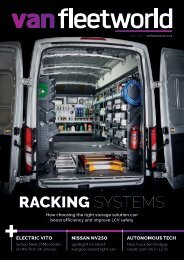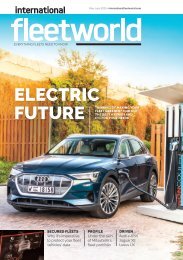Create successful ePaper yourself
Turn your PDF publications into a flip-book with our unique Google optimized e-Paper software.
Businesses can already encourage employees to<br />
use public transport, but these journeys typically<br />
include multiple supplier and complicated route<br />
planning... Transport alternatives have to be userfriendly<br />
to gain traction.<br />
in creating a society where car ownership<br />
is no longer needed,” he says. “This<br />
will result in healthier, safer, cleaner,<br />
greener cities that are less congested.”<br />
However, this is in its infancy in the<br />
UK. In March, the House of Commons<br />
Transport Committee published its<br />
response to last year’s call for evidence<br />
on how such schemes could be implemented.<br />
Local and national government<br />
support would, it said, be vital for<br />
bringing this data together. ACFO,<br />
which was among the organisations<br />
that presented evidence, sees mobility<br />
as a way for fleets to keep track of how<br />
their employees move and for technology<br />
to advise on the right method. But,<br />
it added, today’s solutions need work.<br />
“ACFO has seen numerous apps, for<br />
journey planning and ticket holding,<br />
from various business travel agents, as<br />
well as apps for recording and the<br />
submitting of expenses,” says former<br />
chairman, John Pryor. “But the ability<br />
of a company to join them together is<br />
‘fairly rare’. Consequently, the support<br />
of government towards a more integrated<br />
system will help businesses<br />
adapt and manage their mobility needs<br />
more effectively.”<br />
Matt Dale, head of consultancy at<br />
ALD Automotive, which is offering<br />
bespoke ‘Mobility Experience’ consultations<br />
for businesses looking at travel<br />
solutions beyond the traditional fleet,<br />
also advises caution. “What we’re<br />
seeing is a lot of Mobility-on-Demand.<br />
If you scratch Mobility-on-Demand you<br />
have taxis and public transport. What<br />
we’re seeing with some of these is it’s<br />
cheaper to book your own train than it<br />
is through the app. We are working<br />
towards MaaS, but it’s not there yet.”<br />
New ways of working<br />
The landscape is moving quickly, and<br />
nascent technology isn’t an excuse to<br />
stand still. Europcar Mobility Group<br />
research, conducted last year, showed<br />
only 39% of fleet managers review their<br />
travel policies annually, while almost<br />
10% said they either don’t review it or<br />
don’t know how often they do so. Yet<br />
employees’ behaviour as consumers<br />
means resistance to change might not<br />
be as big as it once was.<br />
“Vehicle travel and the company car<br />
is not so engrained in the psyche of<br />
younger employees today as it was in<br />
yesteryear,” says ICFM director, Peter<br />
Eldridge. “Companies could look to set<br />
a mobility budget for each employee<br />
that will influence the mode of transport<br />
they take, based on a range of<br />
factors including fitness-for-purpose,<br />
cost, convenience and safety. Employees<br />
will be able to access travel options<br />
via their own portal, make bookings<br />
and keep track of their budget.”<br />
So the onus is on operators. The<br />
Energy Saving Trust advises organisations<br />
to develop a ‘travel hierarchy’ for<br />
employees – a flow chart or website<br />
outlining the available options, potentially<br />
including web conferencing to<br />
avoid travelling at all. This not only<br />
reduces ad-hoc grey fleet journeys, but<br />
it ensures employees are using the most<br />
time and cost-efficient modes. Some<br />
forward-thinking fleets are negotiating<br />
discounts with public transport operators<br />
or have mileage policies in place to<br />
incentivise drivers out of their cars.<br />
But the UK has a lot to learn, according<br />
to Craig Grant, head of mobility<br />
services at Alphabet UK: “In the Netherlands<br />
and some other European countries,<br />
Alphabet provides employees of<br />
corporate customers with a ‘mobility<br />
budget’, allowing them to choose the<br />
mode of mobility that best suits their<br />
needs – which could be a car lease,<br />
public transport travel card or even a<br />
cash payment, if they choose active<br />
forms of travel like walking or cycling.<br />
But this budget has to cover all their<br />
business mobility costs, meaning they<br />
can’t then expense a train trip if they’ve<br />
spent all of their mobility budget on a<br />
company car,” he says.<br />
“Ultimately it comes down to mindset<br />
and senior-level buy-in. For those businesses<br />
that can align the various stakeholders<br />
and get key decision-makers to<br />
collaborate, then you can move towards<br />
an understanding of your business’s<br />
true mobility costs, both in money and<br />
in employee time.”<br />
>><br />
fleetworld.co.uk • 033





